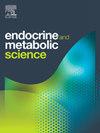The association between metabolic syndrome and gallstone disease: A cross-sectional study from the PERSIAN Guilan cohort study
Q3 Medicine
引用次数: 0
Abstract
Background
There has been a concerning increase in the occurrence of gallstone diseases (GSDs) among individuals with metabolic syndrome (MetS). This study investigated the association between MetS and GSDs and related risk factors.
Methods
This retrospective cross-sectional study was conducted on 10,520 participants from the prospective epidemiological research studies of the Iranian adults (PERSIAN) Guilan cohort study (PGCS) population. Demographic and clinical characteristics, anthropometric parameters, and laboratory findings were collected. National Cholesterol Education Program–Adult Treatment Panel III criteria (NCEP-ATP III) were used to diagnose the MetS. All data was analyzed using SPSS version 26, and a significant level was considered <0.05.
Results
The prevalence of MetS was 41.8 %, with higher rates in females (56.3 %) than males (25.0 %). Also, GSD prevalence was 2.06 %. Abdominal obesity and low high-density lipoprotein (HDL) levels were significantly associated with GSDs (P < 0.05). The presence of MetS increased GSD odds by 47 % (P=0.010). A trend of increasing GSD prevalence with the number of MetS components illustrated a significant relationship ranging from 0.56 % (no components) to 3.60 % (all components) (P < 0.001).
Conclusion
The findings demonstrated that MetS was significantly associated with increased risk of GSDs, of which higher body mass index (BMI), greater waist circumference, and lower HDL level were the most associated risk factors.
代谢综合征与胆结石疾病之间的关系:来自波斯桂兰队列研究的横断面研究
背景:在代谢综合征(MetS)患者中,胆结石疾病(GSDs)的发生率有所增加。本研究探讨MetS与GSDs之间的关系及相关危险因素。方法本回顾性横断面研究对来自伊朗成人(波斯)桂兰队列研究(PGCS)人群的前瞻性流行病学研究的10,520名参与者进行了研究。收集了人口统计学和临床特征、人体测量参数和实验室结果。使用国家胆固醇教育计划-成人治疗小组III标准(NCEP-ATP III)诊断MetS。所有数据采用SPSS version 26进行分析,认为显著水平为<;0.05。结果met的患病率为41.8%,女性(56.3%)高于男性(25.0%)。GSD患病率为2.06%。腹部肥胖和低高密度脂蛋白(HDL)水平与GSDs显著相关(P <;0.05)。MetS的存在使GSD的几率增加了47% (P=0.010)。GSD患病率随MetS成分数量的增加呈上升趋势,其显著关系范围为0.56%(无成分)至3.60%(所有成分)(P <;0.001)。结论MetS与gsd发生风险显著相关,其中BMI、腰围和HDL水平降低是与gsd发生风险最相关的因素。
本文章由计算机程序翻译,如有差异,请以英文原文为准。
求助全文
约1分钟内获得全文
求助全文
来源期刊

Endocrine and Metabolic Science
Medicine-Endocrinology, Diabetes and Metabolism
CiteScore
2.80
自引率
0.00%
发文量
4
审稿时长
84 days
 求助内容:
求助内容: 应助结果提醒方式:
应助结果提醒方式:


